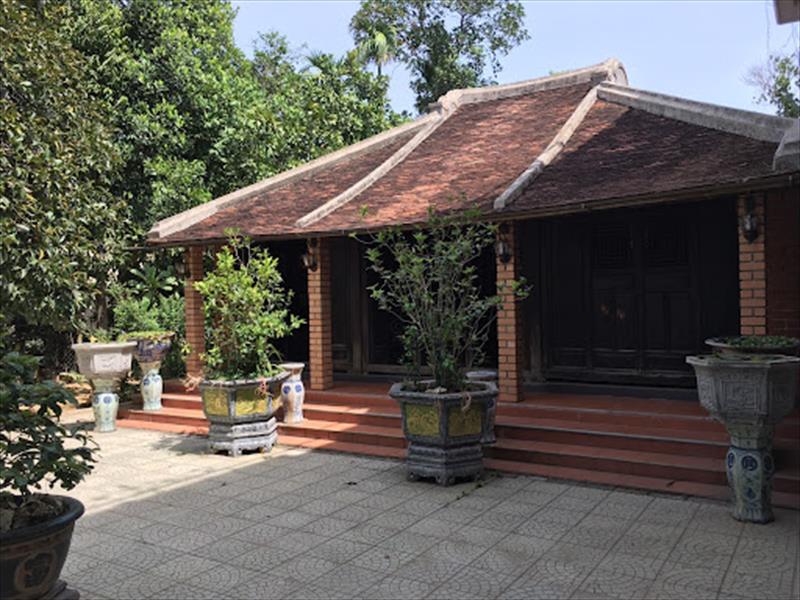Hue communal house - The beauty that remains from Vietnamese feudal culture

From ancient times until now, people have often called Hue the land of dreams, perhaps dreams do not only come from golden palaces, crown jewels, majestic mausoleums, and ancient landscapes, but they are also the dreams of an ancient capital with a peaceful and quiet beauty with lush green gardens and dyed mossy color. Hue communal house represents the harmony between human life and plants, between spiritual and material life, all of which complement each other to create balance in life.
In Hue, a communal house is not simply a place to live, it is considered a work of art, a continuing connection to the family and lineage's traditional communication system and also the next connection of the source circuit of Hue culture in landscape architecture. Just by looking at the space of the house, people can easily recognize the soul and lifestyle of the owner.
Ruong house - also known as the "typical feature" of a finished wooden house in Hue. Cho, tau, kien kien, jackfruit tree trunks,... are the materials that make this architecture sharp. Hue communal houses are often more slender than Dang Ngoai wooden houses, marked by breakthroughs with counter-textures such as dragon-shaped motifs or stylized flowers and leaves on the rooflines or corners. Tourists exploring Hue's ancient houses will find small details elaborately and meticulously engraved, creating a highly aesthetic "embossed picture".
The main house has 3 compartments with 2 wings, the front hall is for the first organized worship work with other special interior decorations such as horizontal lacquered board, parallel sentences, and tureens. The horizontal house is also designed in the style of 3 rooms and 2 wings, connected to the main house by a lovely, discreet bridge roof with the kitchen at the back of the porch. The house has a thick tile roof, hidden under a lush green garden, creating a colorful painting of Peace and Freshness.
Not only the land of the ancient capital but also from the provinces of Quang Binh, Quang Tri to Quang Ngai also have this type of house, but despite that, Ruong house architecture is still considered a specialty of Hue and has become a city and inseparable part of Hue culture.

Ruong house is a type of house with a truss column structure system by a wooden , completely connected by knot corners so that it can be easily disassembled. "Ruong" in the name "ruong house" is a short way of saying "horizontal crossbar and pillar". A special feature of the Hue house is usually a spacious space with green trees surrounding it. And according to the principles of feng shui tactics, there must be a vase that acts as a wind poison in front of the house, or a water tank placed in the yard not only to regulate the temperature but also to make the space more relaxing and pleasant. At the same time, water is also an important factor that contributes to bringing prosperity and wealth to the homeowner.
Hue's biggest advantage is that the upper layer of the house is dense and roofed with tiles. So in the summer, the house's air becomes cool, whereas in the winter it is warm. Besides, Hue Ruong houses have roofs designed with steep slopes, thereby helping rainwater drain faster and becoming suitable for the rainy and windy weather in the last months of the year in Hue.
When preparing materials for construction, the first thing to do is calculate the actual cost. Almost all of the wood in the house is made from jackfruit wood - a precious wood with a yellow color and beautiful grain. From there, it creates solidity, less elasticity, less cracking and has a long life. Next is preparing the horizontal crossbar bamboo. When building, you must choose to buy bamboo trees that have been grown for a long time, must be old, must be hard to avoid woodworms and especially must be cut in early spring. The bamboo will be soaked for 100 days after being processed by the maker in a few basic steps, then it will be exposed to dry, from there the bamboo will be classified according to its intended use and preservation carefully, ensuring no rain.
The final step is to prepare rattan rope, straw and grass. Qualified rattan must be chosen from Song rattan and Ma rattan trees. Thatch grass must be good, old, cut and carefully dried in the sun. Straw after harvesting also needs to be exposed to sunlight and preserved according to standards. Because of the meticulousness in preparing materials, the price of Hue communal houses is quite high.
Hue communal house - it is not only the result of the intellectual creative process of the people here, it is not only a proud achievement in construction techniques but also a unique work of art, a picture of flowery that has been summarized and sketched over many generations. Therefore, the Ruong house became a "pure resident" of the people here, becoming a cultural space with many interesting discoveries for those who want to know more about Hue culture and people here.

